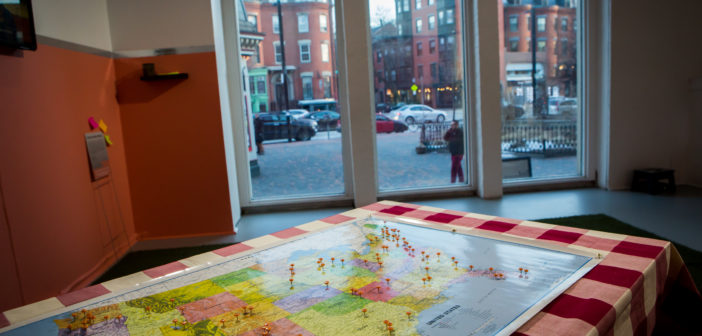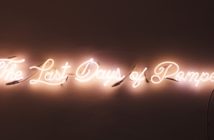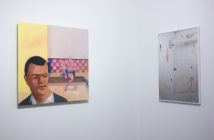Last year, Lucas Spivey parked his vintage Shasta camper on the Boston Center for the Arts Plaza, unfurled the awning, positioned a flamingo lawn ornament, and invited artists of all types inside to discuss business. As the BCA’s public art resident, he offered Mobile Incubator as a connection between the local culture and business sectors through podcasts with entrepreneurs and free advice sessions for artists. Currently, Spivey’s work is back at the BCA as curator of Culture Hustlers: Artists Minding Their Business at the Mills Gallery in an unusual exhibition that explores artists’ business models. Spivey also includes a playful, picnic-area installation documenting the journey of his Mobile Incubator.
Culture Hustlers makes several thought-provoking curatorial choices. From a map bristling with pins showing Mobile Incubator’s path across the U.S., it is clear that Spivey himself did not stop as often in “flyover country” as along each coast. On one hand, this makes sense—the coasts host more easily accessible concentrations of artists. However, in Culture Hustlers Spivey appears to be actively correcting this regional imbalance. Of the five arts business models showcased (each represented by a handful of objects and projects that range from pragmatic to whimsical), three are located in the Midwest or Southwest, with the remaining two on the West Coast. Not only does Culture Hustlers champion artists working outside New York and LA, it offers Bostonians a refreshing escape from the East Coast and a sampling of works in which the distinction between art and craft matters less than the shared creative spirit of the makers.
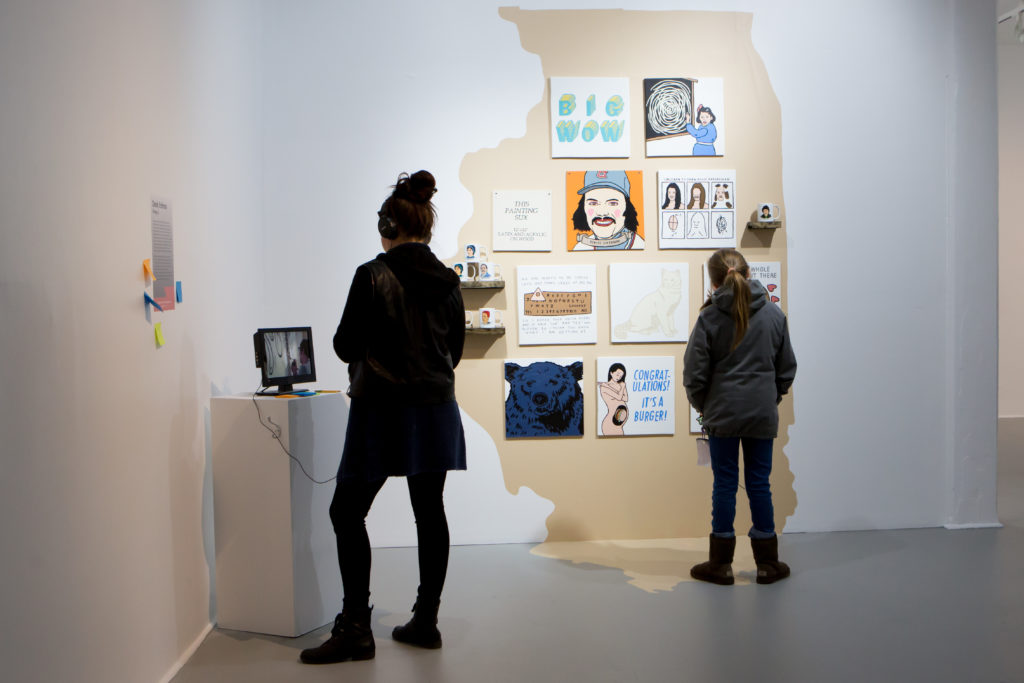
Installation view, Culture Hustlers at Mills Gallery, Boston Center for the Arts, January 2018. Derek Erdman, Chicago, Illinois. Photo by Melissa Blackall.
Yet do Spivey’s choices truly expand viewers’ notions of art-making across America? Not really. Take Española Valley Fiber Arts Center (EVFAC) in New Mexico. The woven art on display is stunning, but it’s also a traditional (indeed, expected) example of Southwestern craft. San Francisco artist and writer Kristin Farr’s, rainbow-hued, geometric murals—expressed in the gallery as two small-scale, acrylic paintings—have an Instagram-ready appeal synonymous with the tech- and social media-obsessed stereotype of California. It comes as no surprise that Farr also developed an art app. Likewise, it’s not difficult to connect the dots between the functionalism of Detroit-based Smith Shop’s fine metalwork and the industrial history of Motor City.
This is hardly a criticism of the makers’ ability to leverage the cultural imperatives and technical expertise of each’s own locality. In fact, that kind of awareness and self-positioning constitutes admirable business sense. Yet, considered as an art exhibition rather than a business lesson, Culture Hustlers may leave some viewers wanting examples that feel less obvious, even as they enjoy the exhibition’s lighthearted visual aspects. Pops of primary color are found throughout, from the sunset warmth of EVFAC member Jennifer Moore’s Rhapsody in Red cotton weaving, to Tieton Mosaic’s single-character, glass tile mosaic featuring a cherry red “@.”
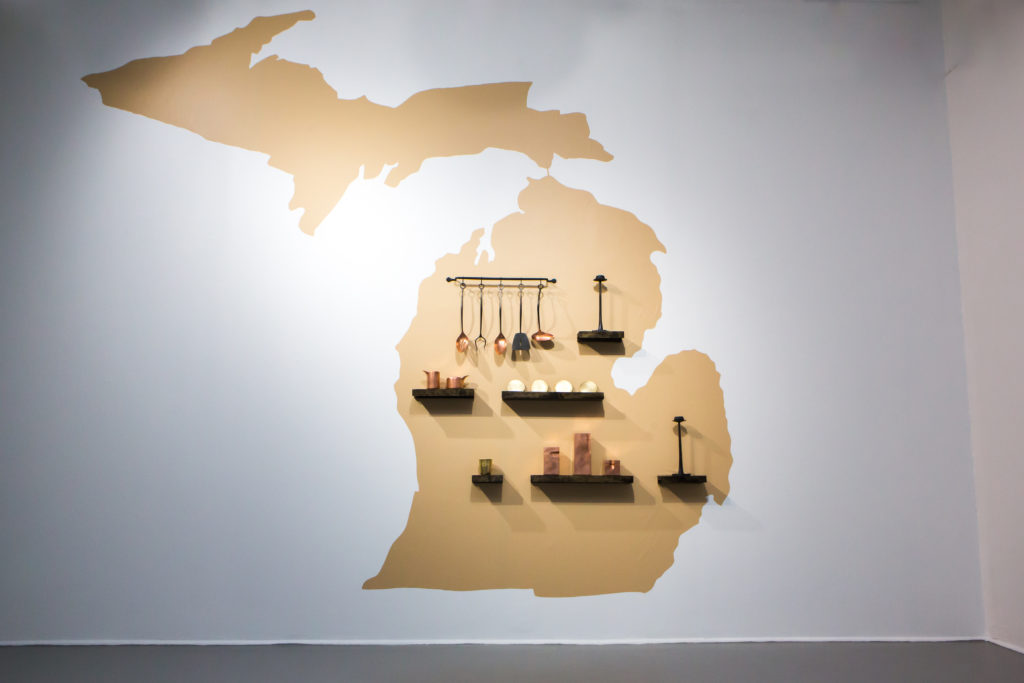
Installation view, Culture Hustlers at Mills Gallery, Boston Center for the Arts, January 2018. Smith Shop, Detroit, Michigan. Photo by Melissa Blackall.
Other aspects of the exhibition are more powerful. The large, wall-vinyl silhouettes of states that “frame” the work are eye-catching, but aside from the installation dedicated to Mobile Incubator, the Mills Gallery’s extensive floor-space is left empty. A large amount of space in between each display encourages viewers to linger, absorbing every detail before moving on. Through this minimal approach, Culture Hustlers resists a surface-level “gallery stroll.” Additionally, its spare aesthetic has a vastness to it that compliments Spivey’s choice to showcase art of the American interior and is suggestive of the endless possibilities open to the cultural sector.
In terms of the actual business of art, the exhibition does not dole out much advice but does suggest several angles for aspiring “culture hustlers” to consider. Here are some possible takeaways. First, there are plenty of business models to choose from, each with its own opportunities. While Tieton Mosaic (Tieton, WA) is a for-profit entity, it was created as a benefit corporation whose earnings would support its legal owner, the nonprofit Tieton Arts & Humanities. Tieton Mosaic is able to use NEA grant funding for projects that not only produce fine works of art but offer invaluable training opportunities, thus fulfilling the parent nonprofit’s mission to facilitate community-based entrepreneurship. Second, protecting intellectual property is an uphill battle. Chicago artist Derek Erdman’s humorous Congratulations It’s A Burger design—which, like most of his work on display, has the graphic wit of a great album cover—was copied and sold without authorization through several web-to-print sites like Zazzle. For its part, EVFAC attempts to raise awareness of indigenous heritage patterns similar to ones that were the subject of a recent lawsuit between Urban Outfitters and the Navajo Nation. The struggle over intellectual property in an era of digital reproduction and corporate greed is a sobering undercurrent to this otherwise celebratory show.
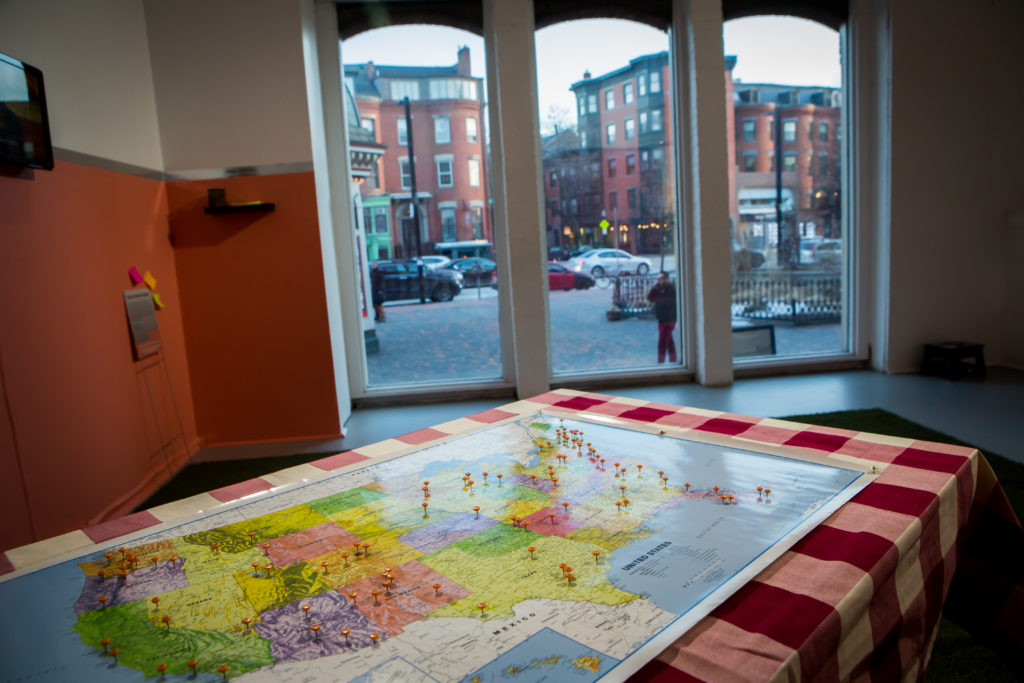
Installation view, Culture Hustlers at Mills Gallery, Boston Center for the Arts, January 2018. Photo by Melissa Blackall.
Finally, Culture Hustlers blurs the line between fine art and fine craft. Within the context of the exhibition, Farr’s acrylic painting Triangle 2 exists comfortably alongside Smith Shop’s Signature Serving Ware Set. The implication is that artists and craftsmen would do well to pay more attention to one another’s strategies for making a living.
Yet in the end, Culture Hustlers is about more than just the hustle. The exhibition’s wide-angle view of art across America is spare but thought-provoking. Leaving the Mills Gallery, one can’t help but wonder about the variety and vibrancy of art-making that didn’t make it into the show, and perhaps that is Spivey’s point. The selected artists (not to mention the business models) are just that—selected. If any show in Boston right now inspires viewers to take a spontaneous road trip in pursuit of more, this is it.
Culture Hustlers: Artists Minding Their Business is on view through April 8.

